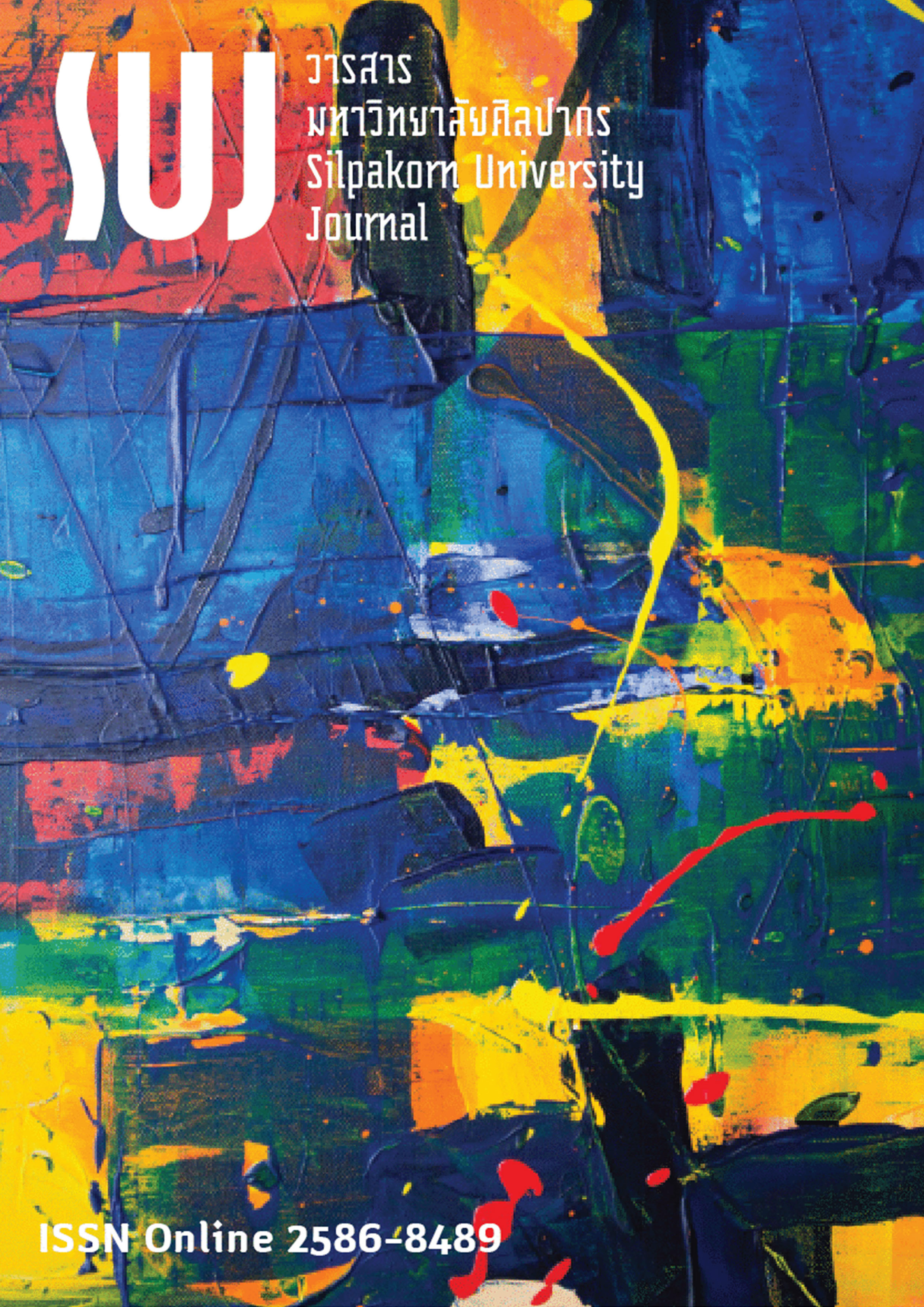แม่สลอง : ดนตรีสร้างสรรค์เชิงวิชาการจากความประทับใจในมรดกภูมิปัญญาทางวัฒนธรรมของจังหวัดเชียงราย (Mae-Salong: creative music with an academic approach inspired by an impression of intangible cultural heritage of Chiang Rai Province)
Main Article Content
Abstract
เชียงราย มีมรดกภูมิปัญญาทางวัฒนธรรมเป็นแบบล้านนา มีกลุ่มคนชาติพันธุ์ที่หลากหลาย จึงเป็นเสน่ห์ของพื้นที่ในการสร้างความประทับใจให้กับผู้คน ดนตรีสร้างสรรค์เชิงวิชาการ อัลบั้ม “แม่สลอง” มีวัตถุประสงค์เพื่อนำเสนอแนวคิด เทคนิคกระบวนการสร้างสรรค์ดนตรีเชิงวิชาการที่ถ่ายทอดมาจากความประทับใจในมรดกภูมิปัญญาทางวัฒนธรรมของจังหวัดเชียงรายของผู้วิจัย ผลการศึกษา ผู้วิจัยได้สร้างสรรค์ผลงานเพลงจำนวน 5 เพลง ได้แก่ 1) “บีซู รวมใจ” ถ่ายทอดความประทับใจในวัฒนธรรมด้านภาษาบีซู มีแนวคิดสร้างความตระหนักถึงวัฒนธรรม ปัญหา อุปสรรคที่เกิดขึ้น และเชิญชวนเยาวชนรวมใจกันรักษาวัฒนธรรมบีซู ใช้ลักษณะดนตรีแบบบอสซาโนวา 2) “ลีซู บลูส์” ถ่ายทอดความประทับใจในวัฒนธรรมดนตรีของกลุ่มชาติพันธุ์ลีซู มีแนวคิดให้เห็นถึงสภาพวิถีชีวิต บรรยากาศประเพณีรื่นเริง ใช้ลักษณะดนตรีแบบแจ๊สบลูส์ 3) “ดอยตุง รุ้งงาม” ถ่ายทอดความประทับใจในตำนานพระธาตุดอยตุง มีแนวคิดให้เห็นถึงความงดงามของสภาพแวดล้อม ความศรัทธาของคนในพื้นที่ ใช้ลักษณะดนตรีแบบสวิงแจ๊ส 4) “แม่สลอง” เป็นความประทับใจในสภาพแวดล้อมตามธรรมชาติของดอยแม่สลอง ถ่ายทอดแนวคิดให้ผู้ฟังเห็นถึงเรื่องราวทางประวัติศาสตร์ สภาพแวดล้อมของพื้นที่ ลักษณะดนตรีแบบสวิงแจ๊ส และ 5) “เพลงดาบก๊ำฟ้าเชียงราย” ถ่ายทอดความประทับใจจากศิลปะการต่อสู้ป้องกันตัว มีแนวคิดให้ผู้ฟังเห็นถึงเรื่องราวความเป็นมา และลีลาท่าทางของเพลงดาบ ใช้ลักษณะดนตรีแบบฟิวชั่น บทเพลงที่แต่งขึ้นมีความยาวโดยรวม 30 นาที และได้ดำเนินการตามองค์ประกอบการสร้างสรรค์ดนตรีเชิงวิชาการ มีการเผยแพร่ในเว็บไซต์ยูทูบ นอกจากนี้สามารถใช้ประโยชน์ทั้งในเชิงทฤษฎีการแต่งเพลง เชิงปฏิบัติเครื่องดนตรี ได้อย่างเหมาะสม
Chiang Rai Province has unique intellectual cultural heritages of Lanna, along with ethnic diversity which became the province’s characteristic. The purposes of the music creation of the “Mae Salong” album was topropose the concepts, techniques, and academic music creation processes from the researcher’s impressions of the intellectual cultural heritages of Chiang Rai Province. As a result of the project, the researcher created five songs. First, “Bisu Ruamjai Song” is a Bossa Nova style of music. It was aimed to convey the impression of Bisu language and to raise cultural awareness of problems and existing obstacles about the language, and to encourage young people to preserve Bisu culture. Second, “Lisu Blues Song” is Blues- Jazz music. It expresses the impression of Lisu’s cultural music. The song is aimed to illuminate Lisu’s life-styles and festive atmosphere. Third, “Doi Tung Rung Ngam Song” is a Swing music style which conveys the impression of the legend of Phra That Doi Tung. The concepts behind this song are the beauty of the environment and faith of local people. Fourth, “Mae Salong Song” is a Swing music style. It conveys the impression of natural environment of Doi Mae Salong. The song highlights historical stories and environment of the area. Fifth, “Dab Kam Fah Chiang Rai Song” is fusion music that conveys the impression of the local martial arts and illustrates historical stories and sword gestures. The total length of these songs was 30 minutes. They were composed according to the elements of academic music creation. These songs were disseminated on YouTube. Also, they can be beneficial for both song composition theories and practical music instruments.
Downloads
Article Details

This work is licensed under a Creative Commons Attribution-NonCommercial-NoDerivatives 4.0 International License.
References
Dhamabutra, Narongrit. (2009). Contemporary Music Composition (การประพันธ์เพลงร่วมสมัย). Bangkok: Chulalongkorn University Press.
Euprasert, Denny. (2011). Generatrix, Compositions for Jazz and Jazz Piano Performance (Generatrix บทประพันธ์เพลงสำหรับวงดนตรีแจ๊สและการแสดงเปียโนแจ๊ส). Rangsit Music Journal, 6(2): 5-21.
Kanteeyaporn, Watchara, & Dhamabutra, Narongrit. (2021). Doctoral Music Composition “Sri Na Korn Ping” for Jazz Ensemble and Lanna Ensemble (ดุษฎีนิพนธ์การประพันธ์เพลง: “ศรีนครพิงค์” สำหรับวงแจ๊สออร์เคสตราและวงเครื่องดนตรีล้านนา). Rangsit Music Journal, 16(1): 88-101.
Laohverapanich, Teerus. (2019). Jazz Theory and Improvisation (ทฤษฎีดนตรีแจ๊สและการอิมโพรไวส์) (2nd ed.). Bangkok: Phatcharada Press.
Opapant, Polwit. (2015). Research on strategic plan for jazz promotion in Thailand (โครงการศึกษาวิจัยการจัดทำแผนยุทธศาสตร์เพื่อส่งเสริมดนตรีแจ๊สในประเทศไทย). Bangkok: Office of Contemporary Art and Culture.
Pancharoen, Natchar. (2016). New Dimensions of Music in Thailand: Integrating Theory into Practice (มิติใหม่ของดนตรีสากลในประเทศไทย : ดนตรีสร้างสรรค์เชิงวิชาการ). In Dontree Litkit (ดนตรีลิขิต : รวมบทความดนตรีสร้างสรรค์เชิงวิชาการ), (pp. 1-19). Bangkok: Tana Press.
Pease, T. (2003). Jazz Composition: Theory and Practice. Boston: Berklee Press.
Srisawat, Boonchuay. (2014). 30 Ethnic Groups in Chiang Rai (30 ชาติในเชียงราย) (8th ed.). Bangkok: Siam Press.
Sungwijit, Jetnipith. (2017). The 8 Memorable Portraits for Modern Jazz (8 ภาพความทรงจำสำหรับวงดนตรีแจ๊สสมัยใหม่). Rangsit Music Journal, 12(2): 43-57.
Suriyut, Supachai, & Premananda, Weerachat. (2016). Music Composition: The Aesthetic Dimension of the Wavy Wind (บทประพันธ์เพลงดุษฎีนิพนธ์ : สายลมในมิติสุนทรียญาณ). Rangsit Music Journal, 11(1): 123-137.
Thaicharoen, Raweewat, Phanuakkarachoke, Ratchakrit, & Boondirek, Pakawan. (2018). How to Apply Theory of Big Band Jazz Composition adapts to Use in Thai Popular Music: Case Study Music in Concert Psalm the Princess (ศึกษาวิธีการประยุกต์ใช้ทฤษฎีการเรียบเรียงเสียงประสานแบบแจ๊สเพื่อปรับใช้ในการเรียบเรียงเพลงไทยสำหรับเครื่องเป่าในวงบิ๊กแบนด์: กรณีศึกษา บทเพลงในคอนเสิร์ตราชนารีสดุดี). Rangsit Music Journal, 13(2): 73-88.
Trakulhun, Wiboon. (2016). Ether-Cosmos Twenty Pieces for Piano (มิติแห่งอากาศธาตุ บทประพันธ์เพลง 20 บท สำหรับเปียโน). Bangkok: Tana Press.


